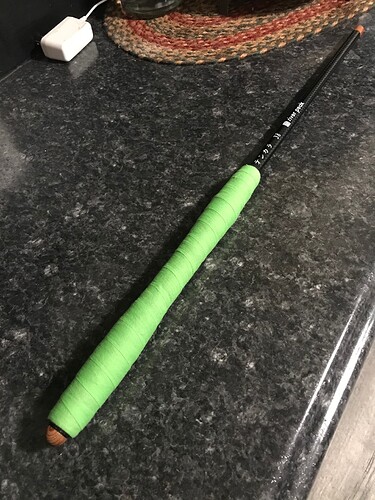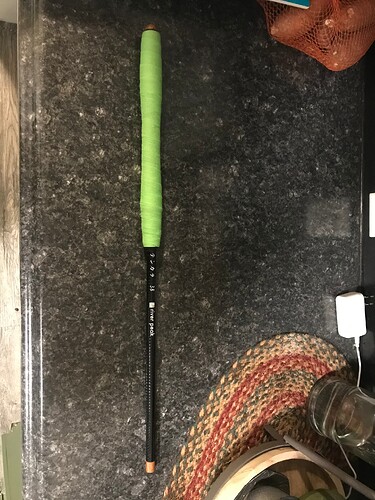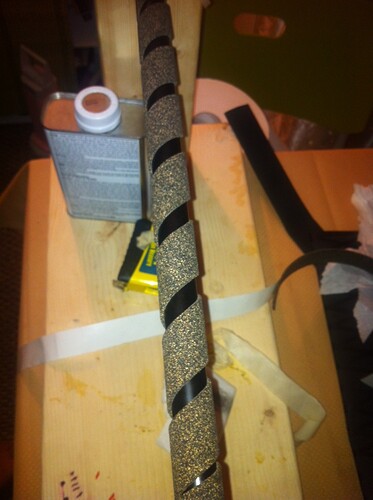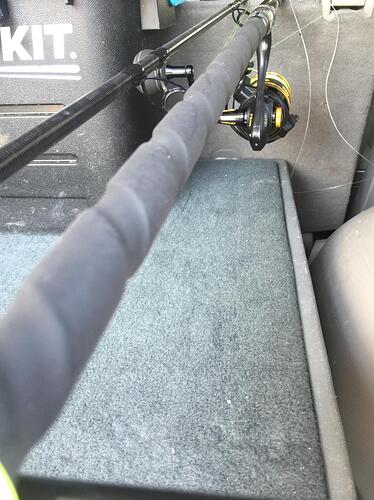So how many of you have modified a grip? I know I have, wish there was a kit for tenkara rods that you could remove a grip and put a carbon fiber grip on I think that would be cool. I know it’s going to change things like weight and balance with the rod but again just an idea. So I picked up a river peak rod and to be honest I really like this rod. Just a fun rod and not being able to fish bamboo tenkara rods I will say it has the feeling of at least what I’m used to with bamboo fly rods. Slow, a little bulky, but a nice fuller flex. My only complaint is the grip, not so much the shape as much but more on how short it is and how thin it is. If they would have made the grip thicker and or longer it would have added some weight BUT it would have balanced it out a lot better. Kinda like the guy who wants to euro nymph with a 11ft fly rod but wants a reel so light that it would balance a 6ft fly rod out. You have to properly distribute weight, doing so will make even a “heavy” rod feel lighter then it is, hence oni rods! But to get back to the grip, I actually used prewrap and tap that you would use in sports. I had a tennis grip on first but actually liked the tap better again it’s personal preference. I was able to shape it better and give it more length. Now I will say I know this isn’t perfect or permanent so we will see how long it lasts but it was a cheap and quick fix for now. Eventually I would like to put a wooden handle on it. So what have you guys done to improve a grip on a rod??
Uploading: FC4B9C3D-325C-4A11-BD84-35718DC81B0A.jpeg…
Processing: D03DC277-7CE8-4E3F-A056-C2C83965867D.jpeg…
Many years ago, I worked in the test lab of a company which makes rocket motors. Then in environmental testing of military and space hardware. This early experience has driven me to “invent” many things and to use a logical approach to problem solving. I’m part-way through addressing a parallel problem as in reshaping handles, to wit; auxiliary handles to enable the use of only some of the more distal sections of a telescoping rod.
Naturally, I no sooner come up with a likely solution, but immediately see a better method. There have been two tracks, additive as in making a mold and subtractive, (as the preferred procedure.) Bear in mind that making a one-off mold, while not inherently expensive, may exceed the scope of the exercise, which is to make shorter rods from a “family of rods.” As an example, one might wish to own several Suntech Kurenai rods. Rather than purchase multiple rods, could we purchase only the longest Kurenai and make separate handles for shorter rods? Staying with our example, Kurenai are available from 30cm up to 6 or 7m lengths, all with the same basic rod and adding a new butt section for each “model.”
This is the method I’m now prepping for and which seems to meet the critera: travel lighter on public transportation, save money and have multiple rods available. Yes, to the sceptics who correctly point out that there are rods that multiplex; I would counter; but then, there those which do not.
- Use the fattest desired rod section as a mandrel.
- Wrap in cling film.
- Paint with Plasti-Dip.
- Epoxy on styrofoam block.
- Shape block to desired thickness and length.
- Epoxy (or use fiberglass resin) and fiberglass tape to wrap and strengthen the foam, using it merely as a lightweight form.
- For the final epoxy coat, dust with fine grit pumice, brushing off the excess after final catalyzing.
- Remove from mandrel and peel off the cling film.
Ah, clever minds ask the question: what about a butt screw? Finding suitable screws has not been a fruitful search, so the present thinking is to buy a cheap rod and scavenge the screw.
Very interesting! While some might not want to do something like this i on the other hand would love a project like this! Being able to make custom grips and shorten rods is very desirable. Tenkara USA did that with the iwana in its early stages and I know a lot of people liked having that option. I think your going in the right direction and I’m Eager to hear more about it! Keep us posted or maybe even put some pictures up of a project rod your working on!
It would be my pleasure to produce a visual of my progress.
But, I confess; my motive for making this public is merely to secure a foundation, proving that it was I that “thunkit.”
I’ve never sought patents, believing that while an expensive partial solution to protecting property rights, it is easily defeated with slight changes–or one may find it very expensive to combat violators.
If the idea proves valid, I think that if anyone wanted to make a business of handle making, a mold would be the better course, but I’m only doing this for myself-ish reasons.
Well I agree! I don’t have the time or energy to make handles for others BUT It would be a great option for me to do for my own rods. As you can see what I’m working with in the pictures above, prewrap and tape hahaha!
If tape works, it is surely the easiest solution to making a handle thicker, but a compound shape change may be difficult.
You may want to consider a partial Barry approach:
-
Get ethafoam… It’s the flexible, closed cell wrap ubiquitously used to wrap everything like furniture and reefers for shipping. It comes in varying thickness so the number of wraps will need to be adjusted. It could be wrapped with more than one layer to get the desired contour.
-
Wrap in fiberglass tape soaked in epoxy and applied to a wetted surface.
-
Add abrasive for a non-slip final finish. Two or three finishing coats with intermediate sanding may be required. Powdered mica is available from Amazon and effectively creates a colored, opaque finish.
Incidentally, this may be one use for which "blenderized, "pulverized, hence fluffy foam butcher’s meat trays are the solution. One draw-back is in keeping it fluffy after adhesive is added. It could be stuffed into a tube to form a lightweight handle.
There are so many ways to skin a cat.
Existing cork can be sanded to new profiles, there are tons of videos on that and replacing cork. Sort of 101 rod building.
Modifying grips with shrink and underlayment like how i demo on this net is another option. Rod building shrink like xflock or you can get eletrical grade shrink. Either work great for improving grip. If you are sealing cork with anytging over it make sure it is 100% sealed and water tight, because if water gets in it cant get out easily and can rot you cork an potentially ruin the blank. trailLite Desings - ti net mods
These are some good options!
I really like that idea! I used to use that stuff when I would fix underground wiring where it would get cut and we had to splice a piece back together, worked great for that! How is it holding up with all the use on your net?
The net shows no sign on wear.
For surfcasting this material is almost exclusively used on all rods. I will use my rod as a walking stick in the boulderfields and it takes several years of that kind of abraison and abuse for it to wear. For a tenkara rod, the material would last forever.
If you go this route be carelful on how much heat you apply in one area too long. You can damage a blank if it sets too hot. Find the lowest temp threshold that the tube will shrink and slowly iterate over areas and move the heat around evenly. It can take some time so be patient.
You can do cork tape underwrapping in a spiral, which is refered to as paco wraps or paco grips.
Okay that looks great! Iv got some thinking to do!



